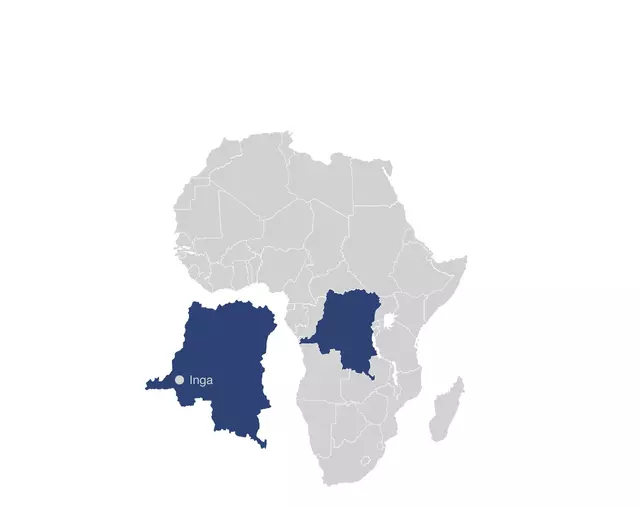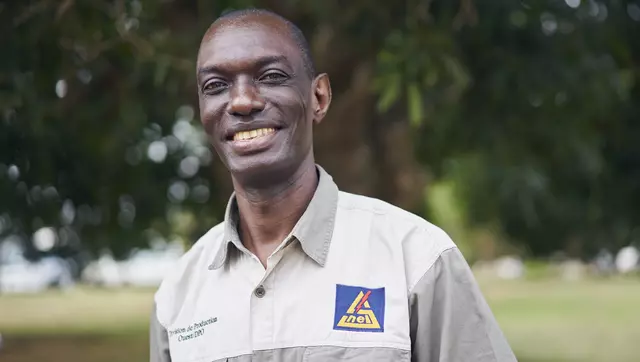Into the future step by step with hydropower
With the modernisation of the Inga 1 hydropower plant in the Democratic Republic of Congo, the national population benefits from a stabilisation of the electricity supply. However, the potential of hydropower for the Central African country is much greater.
Henri Makap A. Muteb is working on a vision so great that it goes beyond the borders of his home country. He is Production Manager West at SNEL, the Société Nationale d'Electricité, which is the state-owned power supply company of the Democratic Republic of Congo. The vision bears the name Grand Inga.
Makap calls Grand Inga "a mega project". The project consists of the future plans for the Inga hydropower plant in the southwest of the country on the Congo River. The river with the greatest hydropower potential in the world makes the Democratic Republic of Congo an important location for hydropower in Africa - with 46,000 MW, almost half of it is located in Inga.


A fraction of the potential at the Inga site has been exhausted to date, only 9% of the population has access to electricity and economic growth is closely linked to energy supply. Frequent power outages are part of everyday life.
If Makap and his colleagues succeed step by step in securing the financing for the next phase of Grand Inga, Inga will not only supply the national population and industry with energy. "The importance of Grand Inga lies in the possibility of exporting hydropower, because the generation of hydropower for Africa and the world from the epicentre will lead to widely spread infrastructure projects," reports Makap. Inga's potential is so huge that even the Middle East and Europe could be supplied with electricity.

The successful modernisation of Inga 1
SNEL still has a long way to go before this vision becomes reality. However, the first steps on the way to achieving the big goal have already been successful. In July 2013, with a World Bank financing, the go-ahead was given for Inga 1 – an extensive modernisation of two generator-turbine units, which was successfully completed in June 2018. Two further units are under rehabilitation in parallel in the Inga 2 project.
At the power plant, which went into operation in the early 1970s, some of the machines already had up to 200,000 operating hours at the start of the project. "Normally, machines like those from Inga 1 have to be thoroughly overhauled after only 40,000 operating hours," reports Makap. For Stéphane Francin, Project Manager for Inga 1 at Voith Hydro, this was also a challenging project:
Francin now proudly looks back on a project in which he and his team from Voith, project partners Elecnor, Fichtner and SNEL jointly succeeded in closing this gap and increasing the efficiency of the machines during the course of the rehabilitation. "SNEL now has a modern, robust and reliable system that simplifies operation and makes production predictable and more stable."
As a result of this rehabilitation, the two new units, each with a capacity of 58,5 MW, will continue to contribute to ensuring a secure energy supply in the Democratic Republic of Congo in the future.






Overcoming local challenges
The rehabilitation of Inga 1 was not only a technical challenge. "Local conditions and regulations are changing rapidly and require a high degree of responsiveness," reports Stéphane Francin. In a country where war is raging in some regions and local infrastructure is obsolete, it is not easy to organize the import and transport of machinery and to manage the logistics of equipment and people.
For Francin, the key to success lies in close cooperation with the customer and local experts: "All teams worked closely together to ensure the technical execution, compliance with planning and the resolving of problems along the way. Weekly meetings, quarterly steering meetings and monthly progress reports were held as well as regular meetings with the World Bank".
Equipped for the next 30 years with cutting-edge technology
Henri Makap A. Muteb looks back on a successful project. He sees the high investment volume as an investment in the future: The rehabilitation of the machines is to last for the next 20 to 30 years.
The project also pays off for him, the Inga team and the local population on another front: important jobs have been created. The successful transfer of knowledge through the implementation of the latest technologies and extensive trainings has prepared the Inga site for the future:
Scope of Services Inga 1
- Rehabilitation of 2 turbine generator units
- Electrical equipment & control technology
Technical Data Turbine
- Vertical Francis turbines
- 58.5 MW capacity
- Drop height 50 m
- Flow rate 140m³/s
- Synchronous speed 136.4 rpm
Technical Data Generator
- Power 65 MVA
- Tension 11kV
- Frequency 50Hz
- Cos Phi 0,85
The project was financed by the World Bank in the PMEDE project, a project to support energy supply in the Democratic Republic of Congo




